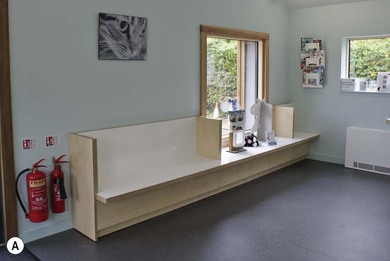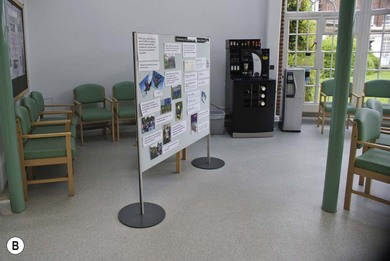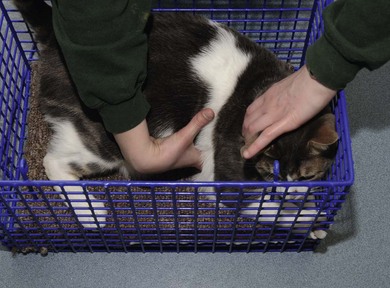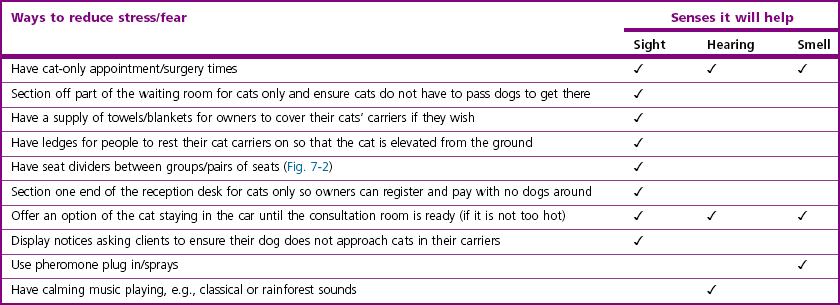Chapter 7 Fear and anxiety in cats may first manifest as changes in ear position, eyes and facial expression, body position, sweating from the paw pads, and tail movement (Figure 7-1).1 Fearful cats may attempt escape, and vocalization such as hissing can indicate an escalation in stress. Overt aggressive behavior can include scratching and biting. Some fearful cats will freeze. It can sometimes be difficult to distinguish between stressed and fearful cats with those in pain. The cat-friendly practice publications and feline-friendly handling guidelines contain more information about recognition of fear and anxiety in cats.2–4 Figure 7-1 (A) A very scared feral cat with flattened ears and narrowed eyes. This cat is recovering after surgery for a hip fracture and hip dislocation and cesarean. (B) A cat showing mild signs of fear, seated at the rear of the cage, with dilated pupils and pricked ears. (C) A fearful cat with the classic ‘bottlebrush’ tail and arched back indicating fear escalating to aggression. In the reception area or waiting room one of the most typical causes of stress is the sight, smell and sound of dogs. So one of the main aims is to keep these two species separate. Stress can be significantly reduced by having a separate waiting room for cats; however, this may not be possible for many mixed practices, so some alternative options are available (Table 7-1 and Fig. 7-2). If a cat-only waiting room is not possible then moving the cat out of the waiting room into the examination room as quickly as possible can be helpful, particularly if there are barking dogs in the waiting room. Wide shelves on the wall or benches, and a ledge near reception for placing the carrier on prevent the need to place the cat at ground level, which is also dog level and can be intimidating and fearful for the cat. Figure 7-2 Options for feline-friendly waiting rooms. (A) A feline-only waiting room; the bench has been specially designed for cat carriers to be placed on them, and partitions provide the option of not placing cats adjacent to each other. (B) A section of this mixed cat and dog waiting room is divided by a screen to provide separate areas for cats and dogs. ([A] Courtesy of Cambridge Cat Clinic.) Within the consulting room, the first sources of stress that need to be considered will come from the general environment and in particularly the smell, sounds and lighting. Many of the ideas suggested in Table 7-1 can also be incorporated into the consulting room and again it is essential to try and ‘see’ the consulting room from a cat’s point of view. The other source of stress will be the structure of the consultation and the approach of the attending clinician or nurse to the cat. The consulting room should be suitable and secure so that the cat carrier can be placed on the ground and the door opened. It will be much less stressful for the cat if it is allowed to come out of the carrier on its own accord rather than have a pair of unfamiliar hands dragging it out. Cats that will not leave the carrier should be lifted out by removing the top of the carrier, if this is possible; it is much less confrontational to lift the cat from above than to pull the cat out from the front opening (Fig. 7-3). Top opening baskets are therefore recommended for cats. Figure 7-3 Cat basket with a top opening lid provides easy access for gently removing the cat from the basket. Offering guidance to owners as to how they should behave around their cat and how to interact positively with their cat to help reduce its stress levels can also help (Box 7-2), but care should be taken to present this in an empathetic manner.
Cats in the practice
Reducing feline stress in the practice
Stress recognition

Waiting room


The consultation
The consulting room





